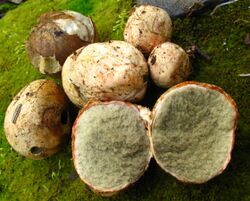Biology:Rhizopogon evadens
| Rhizopogon evadens | |
|---|---|

| |
| Scientific classification Error creating thumbnail: Unable to save thumbnail to destination
| |
| Domain: | Eukaryota |
| Kingdom: | Fungi |
| Division: | Basidiomycota |
| Class: | Agaricomycetes |
| Order: | Boletales |
| Family: | Rhizopogonaceae |
| Genus: | Rhizopogon |
| Species: | R. evadens
|
| Binomial name | |
| Rhizopogon evadens A.H.Sm. (1966)
| |
| Synonyms[1] | |
| |
Rhizopogon evadens is a truffle-like fungus in the family Rhizopogonaceae. Found in North America, it was described as new to science by American mycologist Alexander H. Smith in 1966.[2] The fungus produces roundish to irregularly shaped fruitbodies measuring 2–5 cm (0.8–2.0 in) in diameter, with irregular lobes, wrinkles and depressions on the surface.[3] The peridium (outer tissue layer of the fruitbody) is whitish with light yellow to brown stains, and bruises red. The fungus has an unpleasant odor and a taste described as "metallic". Typical tree associates include pine, Douglas fir, and hemlock.[4] Initially white, the gleba (the interior contents) turn olive to olive-brown in maturity, with the contents developing a gelatinous consistency.[3] The smooth spores of R. evadens are narrowly ellipsoid in shape, and measure 6–8 by 2–2.3 µm.[4]
References
- ↑ "GSD Species Synonymy: Rhizopogon evadens A.H. Sm.". Species Fungorum. CAB International. http://www.speciesfungorum.org/GSD/GSDspecies.asp?RecordID=338407. Retrieved 2015-06-17.
- ↑ Smith AH. (1966). "A preliminary account of the North American species of Rhizopogon". Memoirs of the New York Botanical Garden 14 (2): 151.
- ↑ 3.0 3.1 States JS. (1990). Mushrooms and Truffles of the Southwest. University of Arizona Press. p. 197. ISBN 978-0-8165-1192-1. https://books.google.com/books?id=WIsWN-wpnb0C&pg=PA197.
- ↑ 4.0 4.1 Field Guide to North American Truffles: Hunting, Identifying, and Enjoying the World's Most Prized Fungi. Berkeley, California: Ten Speed Press. 2007. p. 72. ISBN 978-1-58008-862-6.
External links
Wikidata ☰ Q20721645 entry
 |

